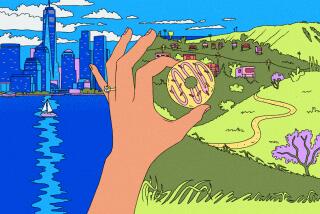MEMORY CENTRAL : Recalling Signs of a Former Life on the Avenue of a Fatherâs Dreams
It seemed the hard, gray, sparkle-flecked cement went on forever. Foot traffic was sparse except at the beginning and close of business days, as workers went to and from jobs and, briefly, in the early afternoon, when neighborhood schools let out and summer school students raided mom-and-pop stores for snacks before heading home. I spent many of those infernal eternities, a.k.a. vacations, half-mesmerized by relentless heat, half-agitated by fumes from paint and turpentine, standing in the thin shade of the sign shopâs doorway, my eyes and imagination roving the forsaken street of my fatherâs ambition.
The minute regular school ended, Papa drafted us to work at the shop. Every morning after breakfast, except Sunday, heâd load stuff from the garage into the station wagon, then summon us out of the house. I always went reluctantly, envying my baby brother and sister who stayed home with Mama. Me and my brother George were old enough to man the phone, take messages and, in a crunch, paint a sign or two. George, the lucky one, often rode off on a job with Papa, while I was left to tap my fingers on window or desk to the hum of passing cars. The years Papa struggled to keep his Jefferson-area sign shop open seemed interminable. At different times, it was located as far north as Adams and as far south as Slauson--mainly off 43rd Street--but always on Central. Papa was among a small legion of wanna-be entrepreneurs who stubbornly believed someday the avenue would wake from its blighted slumber and reward them for their faith.
The sky above Central Avenue was a monotonous pale blue occasionally broken by a cloud or the silver streak of a sputtering plane. The only time it was fun to look up was when the Goodyear blimp appeared. We would laugh and point until it vanished from view. Papa loved to park in front of the Coca-Cola Building and, once in a while, went inside âon business.â He bought gas at Garlandâs service station near 22nd and haircuts at Oxideanâs barbershop off Adams, next door to that dark hollow of a shoeshine place where cronies gathered to shoot bull and breeze to the rhythm of the buff brush. I remember the mysterious-looking old Elks Hall, where befezzed black men in tuxedos clustered out front after socials, sometimes accompanied by fancy-dressed women. There was Juliaâs, where George and I could hardly consume our plate-sized flapjacks for staring at the stumps of fingers missing from the hands of the enormous aproned man who waited tables. Mama favored Millieâs for hamburgers and fries, and after that closed, Fosterâs Freeze. Iâll remember those giant 50-cent soft vanilla cones for as infuriatingly long as it took Mama to tease them with her tongue.
This was the Central Avenue of my childhood. Only the ghosts of the long-shuttered nightclubs, chicken shacks and bawdy houses were discernible to my petulant heart. The street had declined as new-but-mostly-used auto lots proliferated, Christmas tree lots sprang up during the season and liquor stores blossomed--all foreshadowing an escalating crime rate as poverty increased. I hated the street and its gritty undercurrent of hustle, the stone-faced adults of African descent who seemed to erupt into loud talk and edgy, unrestrained laughter, and the dismissive, calculating whites hasty to conduct business and exit the street before sunset. Black militancy in the â60s brought a spotty revival: The old Dunbar Hotel became a museum; the Elks Hall became a mosque. Until the mid-â80s, one could still buy the tastiest tacos in the universe where Central crossed Manchester.
Papaâs five years gone this winter. And these days, Iâm rarely on the avenue unless Iâm running an errand for Mama. When friends come to visit L.A., I treat them to a safari through the cityâs underbelly. I start on the Sunset Strip for a whiff of glitz. Then, as we drive east, I tell them weâll be swinging through Downtown and south into Watts along what was once my fatherâs favorite street. Itâs called Central Avenue. It was the Sunset Boulevard of his glory days.


